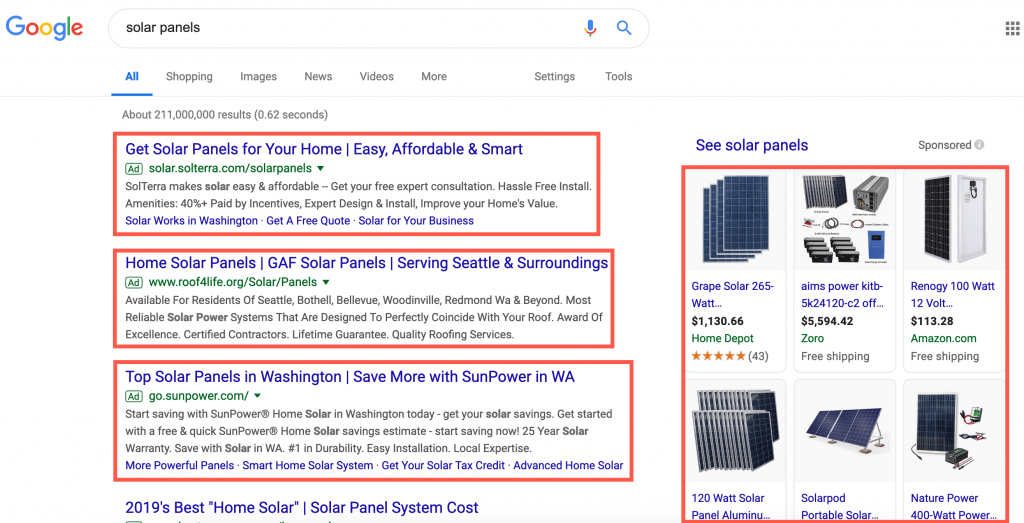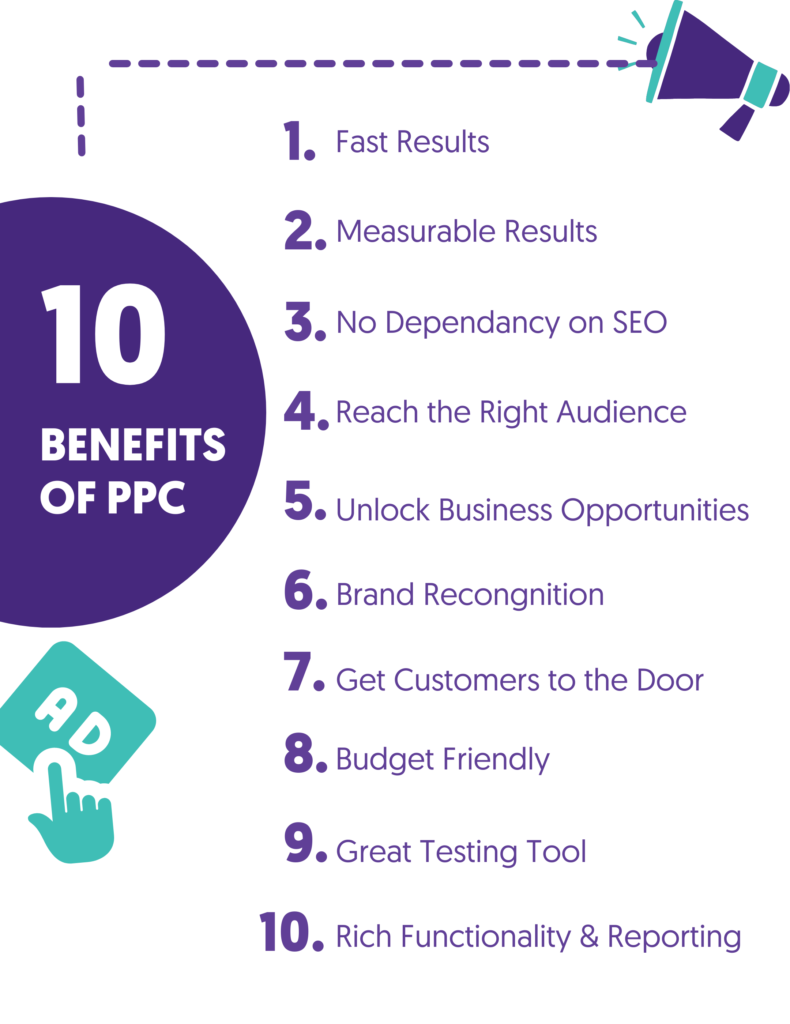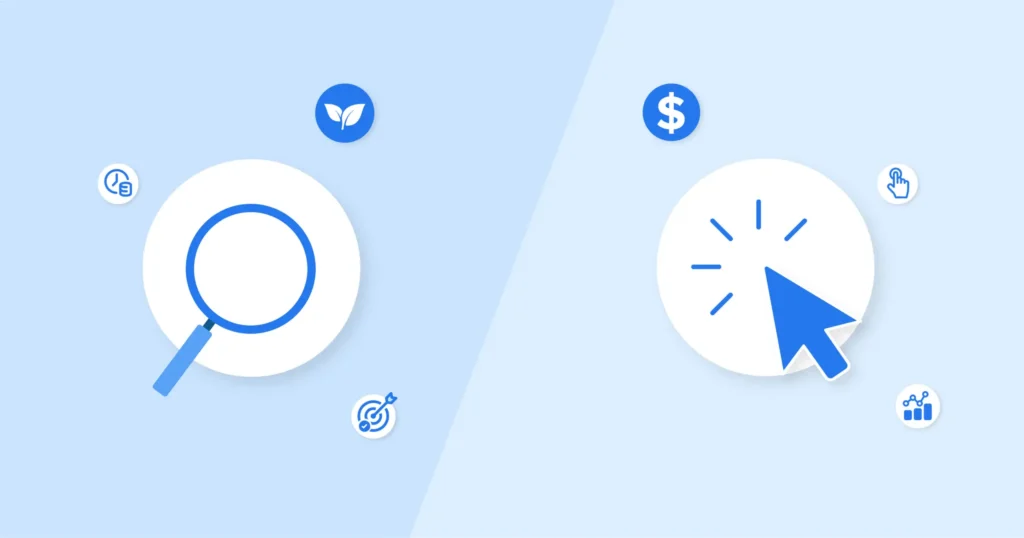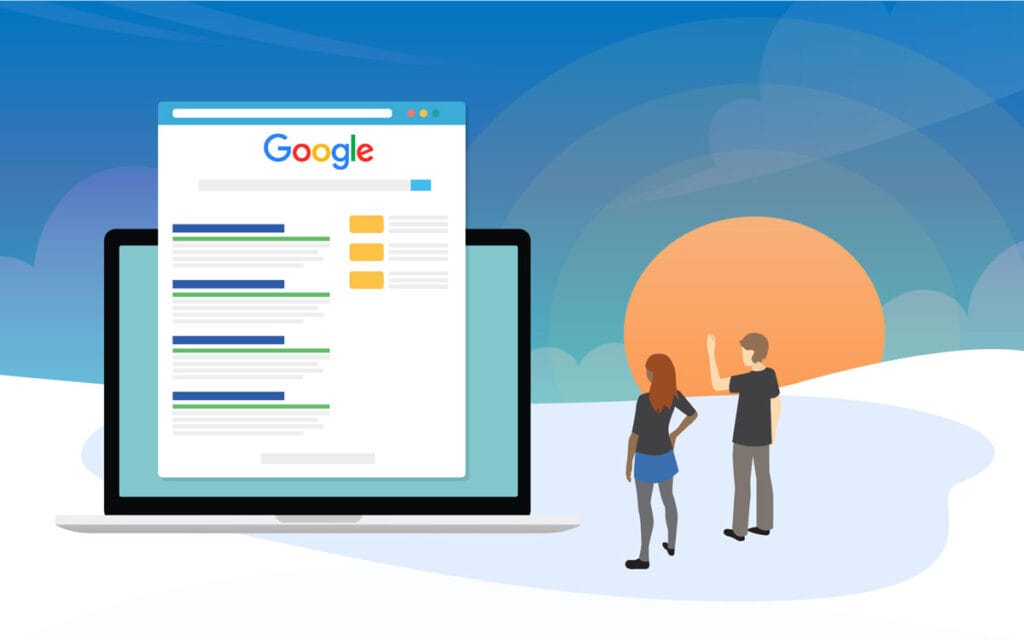PPC Advertising: Boost Your Business with Pay-Per-Click Marketing
If you do business related to online marketing, there is a probability that you are familiar with pay-per-click (PPC) advertising. Advertisers must pay fees under this digital advertising model every time their ads are clicked. It means you buy visits to your website instead of attempting to “earn” those visits in an organic way.
This form of PPC is one of the most common types of search engine advertisement. These marketers place bids for ad placement as sponsored links when someone searches a keyword relevant to their business offering.
For instance, if we bid on the keyword “PPC software,” our ad may appear in the number one position on the Google results page.
The search engine should be paid a small fee each time our ad is clicked and a visitor is sent to our website. When done right, PPC can charge insignificant amounts because the visit could be more valuable than what you will spend. In other words, we would make huge profits by paying $3 for a click, resulting in $300 sats.
A successful PPC campaign involves researching and selecting keywords and phrases correctly and organising these keywords into campaigns or sets (Bing Ads), well-structured Google Ads or AdWords groups. Also, keep these same principles in mind when optimising your PPC.
Individual campaign-level or ad-level targeting options allow anyone using Google Ads to create a PPC campaign.
This guide touches on all areas, from strategies to platforms, so your next PPC campaign will succeed!
Table of Contents
What Is PPC Advertising?

PPC advertising, or pay-per-click advertising, is a digital marketing practice in which advertisers only have to pay for the actual clicks on their ads. This is in contrast to traditional forms of advertising, such as TV or radio commercials, where brands typically have to pay based on the number of impressions or views an ad receives.
The most common type of PPC ad is the paid search ad. These ads appear when people search for keywords on search engines like Google and Bing.
Advertisers bid on keywords that are relevant to their businesses. Then, when someone searches for one of these keywords, the search engine determines which ads will be shown and in what order they'll appear based on factors including how much the advertiser bids and the quality score assigned by the search engine to each piece of creative.
For example, let's say you're a clothing retailer – you might bid on keywords like “women's dresses” or “online clothing store”. If someone searches for those terms using Google Search (the world's most popular search engine), your ad could appear at the top of their results page.
This increases the chances that a person will click through to your website from there – hence “pay per click”.
One main benefit of PPC advertising is how precisely it allows you to target your audience. You don't waste money showing ads to people who aren't interested; you only pay when someone takes action by clicking on your ad.
So instead of paying upfront for impressions (or potential views), as with traditional display advertising campaigns, you only spend money when a user shows clear intent by clicking through from an ad impression – hence, “pay per click.
This targeted approach means more intelligent allocation of ad spend: rather than trying to reach as many people as possible with a message (and inevitably paying lots for uninterested eyeballs), you concentrate your budget only on getting users who are more likely than others also exposed to your campaign to convert into customers.
How Does PPC Advertising Work?
PPC advertising is conducted via an automated ad auction. When individuals use search engines to query something, the search engine scans through all adverts competing for that particular keyword. Then, it determines which ones to place on the results pages and in what order based on factors such as bid amount and quality score.
To participate in the Ad Auction, advertisers must first bid for relevant keywords and establish a maximum payment they can make for any click on their ads. This auction includes other advertiser’s offers with this bid. Thus, an algorithm of this search engine is used to determine the advertisements displayed during each auction by calculating the highest bidding along with the Quality Score of every advertiser.
In other words, if two advertisers have similar bids and quality scores for the same keyword, one might beat the other by having higher ad extensions or better ad formats. Another way ad auctions work is by determining your cost per click.
For example: If advertiser A has an ad rank of 5 (1 * 5) = 5
Advertiser B has an ad rank of 7 (2 *3.5) = 7
Advertiser C has an ad rank of 7 (1 *7)
The actual CPC is calculated using this formula:
((Ad Rank to Beat / Quality Score) + $0.01)
So, in this case:
(6/4) + $.01 = $1.51
(6/2) + $.01 = $3.01
However, One must remember that these computations show how essential it is to set high max bids and maintain good quality scores.
It's essential for businesses that engage in PPC marketing to choose the right keywords because they should match perfectly with search queries, as no one would see the other.
This means doing some research – use keyword tools like Google’s Keyword Planner to find out what people are searching for and determine which words will likely work best for you.
Also, there are such things as negative keywords. These are those one does not wish their ad to appear in relation to. For example, your ad will not be shown among the results if someone types ‘car' or ‘part-time job'.
Thus, targeting the right keywords can ensure that people looking actively for them can see a company.
Benefits of PPC Advertising

Are you seeking quick ways to generate traffic and customers? Pay-per-click (PPC) advertising could be what you need. Unlike other marketing strategies, PPC delivers speedy results. Your ads can appear on search engine results pages almost immediately after setting up your campaign.
This makes it ideal to drive immediate results or promote time-sensitive offers.
However, speed is not the only reason businesses love PPC advertising. It also offers targeting options that are exact in reaching the right people –those with similar demographic data, interests, and search intent.
For instance, if you are a bakery owner, you might want to target individuals looking for “birthday cakes” within a 5-mile radius of your store. This company can effectively extend its brick-and-mortar business online by reaching users actively searching for what they’re selling.
Another advantage of PPC advertising is its cost-effectiveness: unlike conventional ad buys where you pay per impression or view, with PPC, payment occurs only when an individual clicks on your advertisement.
This means more control over how you spend your budget and ensures it's being used only on ads that are being engaged with.
Finally, one of the most significant benefits of running a PPC campaign is how measurable it is. With analytics tools and reporting available at both platform level (Google Ads) and third-party level – such as Google Analytics – companies have complete visibility into essential metrics such as click-through rates (CTR), conversion rates (CVR) and return on investment (ROI).
Through this data, informed decisions about future campaigns can be made, potential areas for improvement can be identified, their activity can be optimised accordingly, and information can even be fed into product development or service delivery to improve the overall customer experience.
Which Platforms Can I Use for PPC Advertising?
Regarding PPC advertising, various platforms exist, each with unique characteristics and target audience. Google Ads (formerly known as Google AdWords) is the most well-known platform. It enables businesses to create ads on Google's search engine results pages (SERPs) and other properties like YouTube and Google Maps.
Bing Ads is another popular PPC advertising option. Its user base differs from that of Google Ads, allowing advertisers to reach a distinct audience segment.
Social media sites also offer PPC advertising options. Facebook Ads, Instagram Ads, LinkedIn Ads, and Twitter Ads are just a few examples. Because these platforms have various features and targeting capabilities, they can reach specific audiences based on interests or demographic information.
For instance, if you want to reach professionals in a particular industry or job role with your B2B software company's advertisement, you might consider LinkedIn Ads.
On the other hand, if you're trying to target a younger crowd interested in fashion items with your clothing retailer ad campaign, Instagram ads may be more successful.
Each platform has unique qualities when it comes to targeting choices, ad formats, and reach, so carefully think about what you want to achieve before deciding which ones will work best for your PPC advertising campaigns.
Remember that while self-serve options exist on these platforms for managing and creating your own PPC campaigns, working with digital marketing agencies or hiring someone skilled specifically in pay-per-click management can help provide expertise that ensures everything is set up optimally for maximum results.
What Is the Difference Between PPC Advertising and SEO?

Pay-per-click (PPC) advertising and search engine optimisation (SEO) are effective ways to increase website visibility and drive traffic, but they differ in approach and cost structure.
With PPC, you pay each time someone clicks on your ad. This method allows for immediate visibility and control over ad placement, so you can quickly reach your target audience by appearing at the top of search results. But it requires a budget because you pay for every click.
SEO is a longer-term strategy to get organic rankings without paying per click. By optimising content, site structure and technical factors, businesses can increase their chances of showing up in organic results. You don't make direct payments for each click with SEO campaigns – though there is an ongoing investment in content creation, link-building and website optimisation.
Both methods have pros and cons but can create a comprehensive digital marketing strategy with quick wins and long-term growth. PPC is great for gaining instant or targeted traffic; SEO delivers long-term visibility through sustainable organic traffic.
If getting visible quickly is essential to your business goals or sales targets, then PPC may be right for you. If you take the long view, investing in SEO could deliver sustainable organic traffic over time – reducing reliance on paid-for advertising.
Tips for Running Successful PPC Advertising Campaigns

To execute successful PPC campaigns, you must plan carefully. These tips will help you start:
Perform an in-depth keyword search: However, keyword research is necessary for PPC campaigns. To capture maximum potential customers, one should use all types of words, such as broad match, phrase and exact match.
Google Ads Keyword Planner, SEMrush, or Moz Keyword Explorer are employed in keyword research. This will help you discover top-performing keywords that can increase conversions and drive traffic if you understand their search behaviour.
For instance, a travel agent would like his ads to appear whenever customers seek vacation packages. Therefore, they could use broad-match keywords such as “vacation packages”, phrase-matching keywords like “family vacation packages”, and exactly matching keywords such as “all-inclusive vacation packages”.
Compose an appealing ad text: Prepare a compelling ad that appeals to the audience and emphasises your products’ or services’ unique selling points. Ensure you include relevant keywords within the text, have strong call-to-actions (CTAs), and consider using Ad extensions for extra information.
Ad copy will significantly affect whether people select to click on your ads; therefore, it should be persuasive, in line with user intent (reason why someone searched), and brief.
Companies' ads are likelier to be clicked when they focus on things that annoy or matter most to potential clients.
For instance, a sports equipment dealer might decide to utilise what are known as ad extensions while setting up their ads by putting customer testimonials, star ratings, and pricing details in place.
Enhance landing pages: Ensure that your landing pages correspond to the messaging in your ads and provide a smooth user experience. This can be achieved by optimising your landing pages to load quickly for mobile devices and having clear calls to action.
Landing pages are where users go after clicking on your advertisements; they are also essential to conversion generation. Such pages must connect well with the ad copy and address users’ information needs. By doing this, you will optimise your landing pages and enhance user experiences, increasing the chances of converting them into customers.
For example, an online clothing store might have dedicated landings for various product classes. When someone clicks on an advert for “women’s dresses,” they are directed to a page showing specific dresses.
Regularly monitor and optimise: Monitor how well your PPC campaigns are doing and make adjustments where necessary. Regularly review keyword performance, ad copy performance, and how well landing pages perform so you can identify areas for improvement and optimise them for better results.
PPC advertising is not something you set up once and then forget about; it requires regular monitoring and analysis of performance data if it is going to succeed. By tracking key metrics such as click-through rates (CTR), conversion rates (CR), return on ad spend (ROAS), etc., you can identify underperforming areas of campaigns and then take action based on what the data tells you.
For example, if specific keywords aren't delivering desired results, consider pausing or modifying those keywords. If one ad variant performs exceptionally well, consider allocating more budget to that particular ad variant.
By following these tips, businesses can improve their PPC campaign effectiveness – which means achieving desired outcomes from campaigns becomes more likely, too.
How to Set a Budget for PPC Advertising
The advertising budget for Pay Per Click (PPC) varies based on a business’s objectives, target market and resources available. First, set your overall advertising budget and assign part of it to PPC campaigns. These could include industry competitiveness, average cost per click for target keywords, and potential return on investment (ROI).
As you run campaigns, monitor your spending. It may be the case that a small business with low capital would start conservatively with its PPC budget but later increase it after experiencing success – a positive ROI.
On the other hand, huge businesses with ample cash could easily bump up money allocated to PPC campaigns.
Monitoring campaign performance is also essential, and adjustments should be made when necessary. Businesses can optimise their budgets for maximum ROI by examining metrics like click-through rates (CTR), conversion rate data and cost per acquisition (CPA).
For instance, if a particular PPC campaign has high clicks yet low conversions, there is no efficient budget allocation. This means businesses have to change their budgets and redirect more resources towards better-performing campaigns or keywords to get the best out of their PPC spend.
Common PPC Advertising Strategies
Businesses can use various advertising strategies to optimise their PPC campaigns and achieve the desired results. Here are some common ones:
Geo-targeting: Advertising to people in your target market by selecting specific geographic locations.
Thanks to geo-targeting, businesses can concentrate their advertising efforts on particular regions or areas where they know their target audience exists. This approach improves relevance and increases the likelihood of attracting potential customers by creating ads and messages tailored specifically for those locations.
For example, a local restaurant might employ geo-targeting to ensure that its ads only appear to users within a certain radius of its location – maximising ad relevance while reducing wasted ad spend.
Remarketing: Showing ads to people who have previously visited your website to remind them about your products or services and encourage them to return.
By serving targeted ads as these users browse other websites or social media platforms, remarketing allows businesses to re-engage with people who have already shown an interest in their products or services but have yet to convert. It's a way of increasing brand awareness among these individuals and encouraging them back so they can take some desired action.
For example, an e-commerce store might deploy remarketing tactics designed to show ads featuring products a user has viewed on its website before – reminding the user about these items and encouraging them to make a purchase.
Ad scheduling: Adjust the timing of your ads to show them when your target audience is most likely to be searching or browsing.
Ad scheduling lets you decide when your ads are shown to your target audience. By examining data and understanding how people in your target audience behave, you can schedule your ads to appear during peak times when users will most likely engage with and convert from seeing them. For example, a B2B software company might choose to make its ads active between 9 a.m. and 5 p.m. on weekdays because decision-makers are more likely to look for solutions actively.
A/B testing: Test different versions of your ads – such as other headlines or calls-to-action (CTAs) – to see what works best and drives more clicks/conversions.
A/B testing (also known as ‘split testing') lets you compare how well different versions of an ad perform so you can find out which elements work best. By putting two different headlines, ad copy or CTAs up against each other in a live environment, businesses can collect data and insights to help them optimise their ads for better performance. For example, an online retailer might test two ad headlines against each other to determine which one gets more click-throughs. They could optimise their ad(s) by analysing the results.
By implementing these strategies into PPC campaigns and continuously monitoring their performance over time, businesses can refine their campaigns/achieve better results.
How to Optimise PPC Ads for Better Results

Consider these strategies to optimise your PPC ads for improved results:
Improve ad relevance: Ensure your ads are relevant to your target keywords. Integrate the keywords into your ad copy and match your messaging to a user's search intent.
Ad relevance is a crucial factor in the success of PPC campaigns. By ensuring that your ads align with the keywords you're targeting, you'll increase their visibility and improve their chances of attracting clicks from users actively looking for what you offer.
For example, if you're targeting the keyword “cheap web design services,” ensure that your ad copy highlights affordability and web design services.
Enhance ad extensions: Use extensions, such as site link extensions or call extensions, to provide more information and make your ads more useful and appealing to users.
Ad extensions let you include extra information or links within your ads, which allows users to do more things and increases the likelihood of engagement. Ad extensions can improve your ads' visibility and give users extra ways to interact with your brand.
For example, a home renovation company might use call extensions so its phone number shows up directly in its ad – making it easier for people who see the ad on their phones to call immediately.
Conduct ad format tests: Test out a variety of ad formats, such as text ads, image ads, or video ads, to see which your target audience responds to the most.
Different ad formats impact users differently and may yield different results depending on your industry and target audience. By testing various forms, you can determine the best way to grab your target market's attention and engage with them effectively.
For example, an online fashion retailer could try image and video ads to see which format gets more engagement and conversions.
Optimise landing pages: Ensure you're continuously optimising your landing pages for a seamless user experience that drives conversions. Remember that they should be relevant, easy to navigate, and mobile-friendly.
Landing pages play a crucial role in the conversion process: aligning them with your ad messaging ensures a smooth user experience and increases the likelihood they'll take action.
For instance, an online travel agency might include clear calls-to-action (CTAs), user testimonials or trust signals on their landing page(s) to increase conversions.
You can improve their performance by making these optimisation efforts part of your PPC campaigns.
Tools and Resources to Help With PPC Advertising
Several tools and resources can help you if you want to do PPC. Platforms like Google Ads and Bing Ads have robust advertising interfaces with built-in tools for research, ad creation, and campaign optimisation. Other companies like WordStream or SEMrush offer comprehensive PPC management solutions and analytics.
For instance, Google Ads contains a free Keyword Planner tool that helps businesses find new keywords, predict their performance, and estimate the search volume. SEMrush offers competitive analysis tools to help companies learn about their competitors' PPC strategies.
Your business can gather important information from these tools on what’s happening with your campaigns. By optimising your campaigns regularly using them – typically once a week is a good frequency – you’ll quickly improve.
In summary, PPC ads enable you to extend beyond your site's existing audience–they allow you to reach more people who are probably interested in what you sell.
Using it correctly and having an appropriate strategy will grow online presence and meet any organisation's marketing goals.
Because only some businesses have unlimited funds for marketing, smaller advertisers or beginners in pay-per-click advertising must develop a strategy that works from day one.
This way, when their budget does allow for more clicks at some point down the line, they’ll get real bang for their buck.
But keep in mind: Data must be relied upon to support optimisation efforts!
You might have someone else managing paid search (like us!), but it is helpful to understand a few things here because those “stellar” figures aren’t reflected anywhere close to your bottom line.
